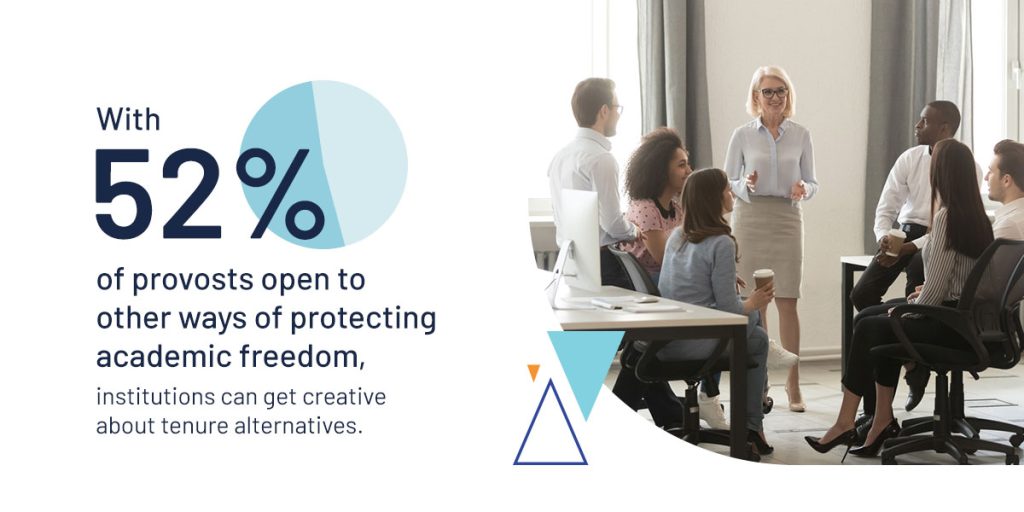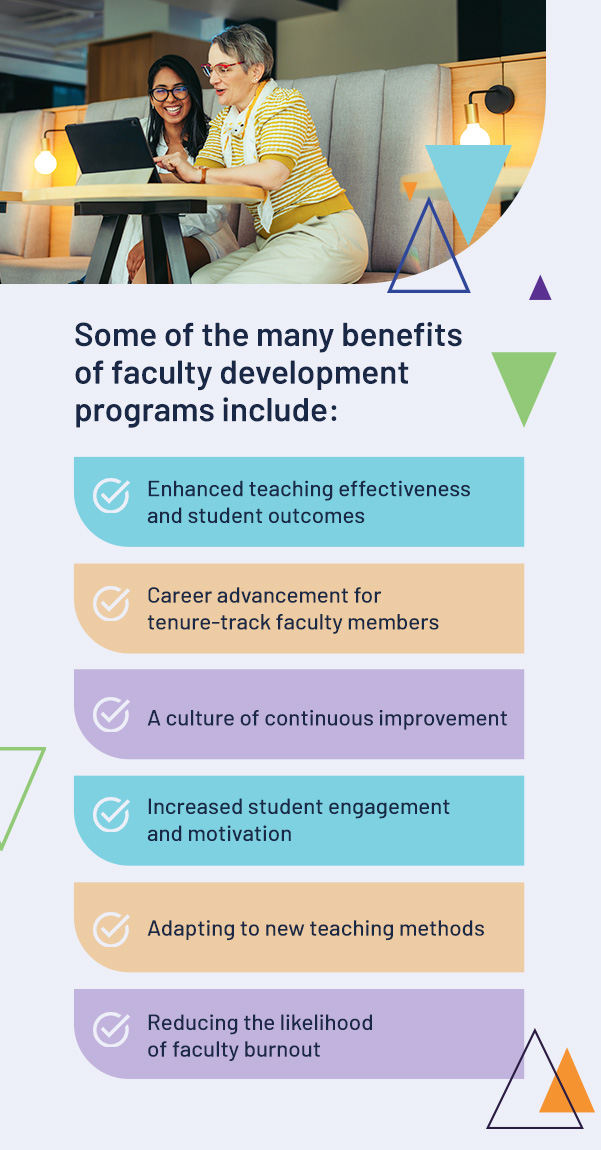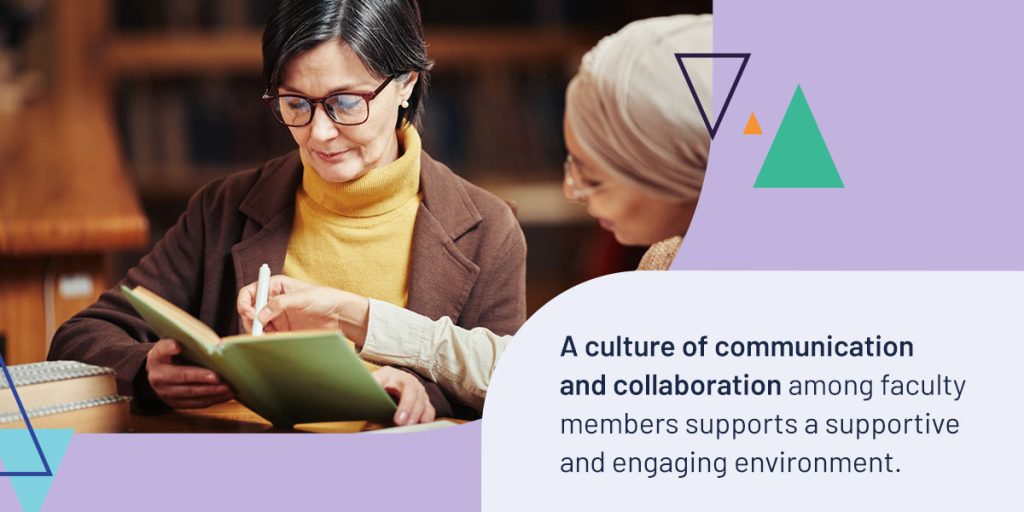




Significant criticisms of faculty tenure in higher education have arisen in the last decade. The result is an uncertain landscape for tenured professors and part-time faculty alike. Administrators must change their approach to faculty development. As institutions grapple with changing enrollment and legislative dynamics, cultivating faculty development becomes increasingly important.
As debates and proposed legislation surround tenure, higher education institutions are reevaluating the role of tenure-track faculty and exploring alternative ways to explore academic freedom and professional advancement. In navigating the current uncertainties, one option comes to the fore — faculty development programs. Strategies to tailor professional development plans and establish a culture of evaluation can help overcome obstacles and support faculty development.
Academic tenure was adopted in the early 20th century to protect faculty members at higher education institutions from interference in teaching and scholarship. Tenure protections mean that faculty can only be dismissed for serious reasons. They can research, teach, and speak on controversial topics without fear of losing their jobs. At one stage, the demand for professors grew faster than the supply, and assistant professors achieved tenure quickly.
Today’s academic environment is vastly different. Enrollment in higher education is stagnant or declining, and the future of tenure is still being determined. Tenure-track faculty members are expensive for institutions. They represent a commitment that many decision-makers are hesitant to take on. Tenure offers job security unlike any other sector, and in recent years, many governors and legislators have proposed legislation to eliminate or restrict it.
Tenure also faces challenges outside of legislation. One force that institutions must understand is the rise of adjunct and part-time faculty. Changing perceptions among faculty is another. While some faculty staunchly defend tenure, others believe it doesn’t improve the quality of higher education. Many are questioning the relevance of tenure in today’s higher education landscape, which means institutions are reevaluating its purpose.
Despite the movement to change the future of tenured and tenure-track professors, no state has yet banned tenure completely. The proposed legislation was either diluted or stopped before passage. As expected, faculty members put up a fight for their academic freedom. Many institutions also claim that retaining tenure helps them recruit high-quality professors.
State lawmakers continue to push for the legislation, and the future of tenure remains uncertain. Faculty members feel the pinch and may feel they must censor themselves or their curricula to protect their jobs. Tenure-ban bills will likely crop up again, joining the 13 bills in 2021 and 2022. This uncertainty means that higher education institutions must rethink faculty development to replicate the security that tenure provides. With 52% of provosts open to other ways of protecting academic freedom, institutions can get creative about tenure alternatives.

One way your institution can support faculty’s continuous growth and success is with a faculty development program. When you develop a strategy that allows assistant, part-time, and full-time faculty to reach their potential, you remove some of the uncertainty they face. With technology and academic experiences evolving yearly, faculty need help staying current with the latest teaching strategies.
As your faculty have built their careers around education, they understand the importance of continuous improvement in their learning. Many will find other learning opportunities if they lack options at their institution. Investing in faculty training is more important than ever in today’s higher education space.
Some of the many benefits of faculty development programs include:

Although faculty development programs are undeniably crucial, implementing them can be challenging. Overcoming these challenges is essential to provide faculty security in an uncertain landscape. Even faculty members who believe in the effectiveness of your program may drop out for reasons as simple as scheduling clashes. Without faculty support, your program will flounder, which impacts your overall institutional goals.
Some challenges include:
Despite these challenges, creating a faculty development program is well worth it. The trick is to find a workable strategy amid the myriad options. Some actionable strategies to cultivate faculty development include:
People respond better to personalized instruction. You can use self-assessment, peer evaluation, and student feedback to monitor performance and personalize your offerings. Consider where each faculty member needs the most guidance — technology, people, or specialty training. You can find the best resources to help them grow in these areas from there. Your professional development programs should also include long-term support, like mentorship programs, coaching, and communities of practice.
Students and faculty need engagement and motivation. Your faculty development program will benefit from promoting hands-on workshops that allow them to experience active learning. Consider incorporating flipped classrooms, collaborative projects, and problem-based learning.
The better your faculty understands diverse backgrounds and perspectives, the more culturally competent they become. Train them to understand the cultural contexts of each student. Give them the resources to incorporate diverse perspectives into the curriculum to create a welcoming and supportive learning environment. Make sure they know that they must make digital resources available to all students.
For a faculty development program to take off, every member of your faculty must be behind it. Continuous improvement should permeate every aspect of your culture. Collect and analyze data on teaching effectiveness, student outcomes, and faculty performance. You can use this data to identify the strengths and growth areas of your faculty to provide tailored support.
Another crucial element of this culture is celebrating wins. Encourage faculty to participate in development programs by recognizing and celebrating faculty members who commit to continuous improvement.
Whether part-time instructors, assistant professors, or tenure-track faculty, your team shares one goal — improving student engagement and academic outcomes. Engage all faculty members in professional learning and give them opportunities to collaborate. Faculty need support at every level, and mentoring programs benefit newer and experienced faculty alike. Mentorship creates reciprocal relationships, an effective way of developing real-time solutions to complex issues.
Your faculty generates masses of data during their daily activities, which plays a crucial role in monitoring progress. Data collection and analysis provide real-time insight into the effectiveness of your faculty development program. One rich source of actionable data is regular assessments that measure the impact of training sessions, workshops, and mentoring programs on faculty skills. Collecting feedback from participants in your development programs and analyzing quantitative data on faculty performance helps you identify improvement opportunities.
You can also use data to identify patterns in faculty development needs across departments. Data on faculty performance, professional goals, and growth areas helps you tailor your development programs to provide targeted support for each faculty member. Data also enables you to allocate resources more effectively. You can identify areas of high impact and prioritize faculty development initiatives that align with your institutional goals.
Peer observation and feedback processes encourage collaboration among faculty members. Encouraging them to observe each other’s teaching practices and provide constructive feedback is essential for continuous improvement. This strategy lets faculty members learn from their colleagues and share best practices. Over time, they gather valuable insights into diverse teaching methods. A culture of communication and collaboration among faculty members supports a supportive and engaging environment.

With positive peer observation, your faculty can engage in meaningful discussions about pedagogical approaches, cultural competence, and classroom management strategies. This collaborative reflection and dialogue is integral to continuous improvement. It creates a culture of lifelong learning throughout your faculty, helping them stay agile in a changing education landscape.
In times of uncertainty, everyone on a team looks to their leadership. Faculty development filters down from the top, which puts you in a unique position to improve faculty outcomes across your institution. Tenure may have an uncertain future, but leadership is about learning and generating ideas together. Leadership skills are a hot commodity in today’s landscape, and current leaders can grow the skills of future generations.
One approach is for leaders to build teams of potential successors for administrative positions, governing bodies, committees, instructors, and academic advisors. This team of people ensures sustained forward movement and embodies your culture of continuous improvement.
Leaders can take the following steps to improve faculty development outcomes:
Successful faculty development programs are the opposite of incidental. They have a clear strategy and goals. When you make a commitment beyond faculty growth, it’s more than an announcement. It’s having a strong advocate at the highest levels who sets measurable goals, analyzes the effectiveness of programs, and builds a culture of continuous improvement. These leaders ensure the proper allocation of resources through data-driven decision-making. Appoint a faculty development coordinator who visibly promotes and rewards faculty development.
Many faculty members desire professional development opportunities but lack the resources to pay for external courses. Only some higher education institutions offer different skills development courses, and giving your team options empowers them to choose their professional development path. Providing leadership and other skills training on campus tells your faculty that you value those skills for everyone instead of elite groups.
When your faculty can see the data behind the decisions, they can better tailor their efforts to gaps in their teaching. Gathering and synthesizing your data in one platform lets everyone see the big picture. With real-time data, they can focus on improvement opportunities and leverage your professional development program. Share your data with them and encourage collaboration, and you’ll build a culture of continuous improvement that thrives on professional development.

While the future of tenure is still unclear, prioritizing faculty development is critical to creating a thriving academic environment. Engaging your faculty is crucial, and a faculty development program supports collaboration and a culture of continuous improvement. With data, you can refine your faculty development strategy with clear objectives and actionable insights.
Watermark Faculty Success is a centralized hub for your faculty data that helps you support your faculty’s career growth. It gives you access to your data on demand, allowing you to facilitate reviews and faculty development from a user-friendly interface. As part of Watermark’s robust Educational Impact Suite (IES), Faculty Success uncovers insights that help you drive progress throughout your faculty. Recognize faculty achievements and nurture professional growth with Watermark. Request a demo of our solutions and boost your faculty development program today!





























































































































































































































































































































































































